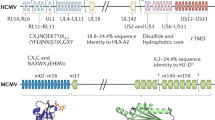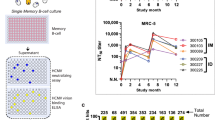Abstract
Influenza virus-specific cytotoxic T lymphocyte (CTLs) can be obtained from mice and humans infected with influenza A viruses1,2 and appear to be beneficial in the host response3. The viral target structure recognized by influenza virus-specific CTLs remains a controversial question for two reasons: first, previous specificity analyses were difficult to interpret because of heterogeneous CTL populations, and second, more than one viral protein has been detected serologically on the surface of influenza-infected cells4–10. To avoid these problems, anti-influenza A/PR/8/34 CTL clones were generated and tested for cytolytic activity on target cells infected with recombinant viruses containing known rearrangements of the genes of strains A/PR/8/34 and A/HK/1/68. We report here that one such CTL line lysed target cells only if the infecting virus possessed the polymerase gene P3 of A/PR/8/34. This suggests that the P3 gene product either induces a virus-specific cell-surface antigenic modification or is expressed on the surface of the infected cell, and hence is involved in recognition of target cells by the anti-influenza CTL line.
This is a preview of subscription content, access via your institution
Access options
Subscribe to this journal
Receive 51 print issues and online access
$199.00 per year
only $3.90 per issue
Buy this article
- Purchase on Springer Link
- Instant access to full article PDF
Prices may be subject to local taxes which are calculated during checkout
Similar content being viewed by others
References
Doherty, P. C., Effros, R. B. & Bennink, J. Proc. natn. Acad. Sci. U.S.A. 74, 1209–1213 (1977).
McMichael, A. J. exp. Med. 148, 1458–1467 (1978).
Yap, K. L., Ada, G. L. & McKenzie, I. F. C. Nature 273, 238–239 (1978).
Compans, R. W. & Klenk, H. D. Compreh. Virol. 13, 293–407 (1979).
Yewdell, J. W., Frank, E. & Gerhard, W. J. Immun. 126, 1814–1819 (1981).
Virelizier, J. L., Allison, A., Oxford, C. & Schild, G. C. Nature 266, 52–54 (1977).
Ada, G. L. & Yap, K. L. J. gen. Virol. 42, 541–553 (1979).
Reiss, C. S. & Schulman, J. L. Infect. Immunity 29, 719–723 (1980).
Braciale, T. J. exp. Med. 146, 673–689 (1977).
Hackett, C. J., Askonas, B. A., Webster, R. G. & Van Wyke, K. J. exp. Med. 151, 1014–1025 (1980).
von Boehmer, H. et al. Eur. J. Immun. 9, 592–597 (1979).
Haas, W. & von Boehmer, H. Behring Inst. Mitt 67, 176–181 (1980).
Sarmiento, M., Glasebrook, A. L. & Fitch, F. W. J. Immun. 125, 2665–2672 (1980).
Palese, P. Cell 10, 1–10 (1977).
Caliguiri, L. A. & Compans, R. W. J. Virol. 14, 191–197 (1974).
Inglis, S. C., Carroll, A. R., Lamb, R. A. & Mahy, B. W. J. Virology 74, 489–503 (1976).
Palese, P., Ritchey, M. B. & Schulman, J. L. J. Virol. 21, 1187–1195 (1977).
Heller, E. & Scholtissek, C. J. gen. Virol. 49, 133–139 (1980).
Author information
Authors and Affiliations
Rights and permissions
About this article
Cite this article
Bennink, J., Yewdell, J. & Gerhard, W. A viral polymerase involved in recognition of influenza virus-infected cells by a cytotoxic T-cell clone. Nature 296, 75–76 (1982). https://doi.org/10.1038/296075a0
Received:
Accepted:
Issue Date:
DOI: https://doi.org/10.1038/296075a0
This article is cited by
-
From influenza to HIV—and back?
Nature Immunology (2007)
-
Twenty years into the saga of MHC‐restriction
Immunology & Cell Biology (1994)
-
Role of class I molecules of the major histocompatibility complex in cytotoxic T-cell function in health and disease
Springer Seminars in Immunopathology (1992)
Comments
By submitting a comment you agree to abide by our Terms and Community Guidelines. If you find something abusive or that does not comply with our terms or guidelines please flag it as inappropriate.



